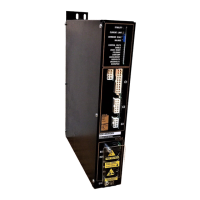C
HAPTER
4 - M
AINTENANCE
BDS
4-4
When altering the response of the system, it may be
necessary to adjust both the STABILITY and the
CURRENT LIMIT adjustments.
4.4.2.1 Stability Adjustment
In many cases, the Stability Pot will not need to be
adjusted and may be left in its fully CCW position.
However, this pot can be used to improve the
dynamic response of the servo loop, by adjusting the
Dynamic (AC) Gain. To adjust the AC Gain to the
proper point, use an oscilloscope to monitor the
internal tach signal at the SPEED MONITOR test
point with respect to A-COM (refer to Figures 1 and
3). Use a second channel of the scope to monitor the
current signal at the I MONITOR test point, also with
respect to A-COM (refer to Figures 1 and 3). Turn
the STABILITY Pot fully CCW. Apply a step input
(rapid) command signal. While accelerating and
decelerating the motor at approximately 25% of
maximum speed, adjust the STABILITY Pot CW
and notice the tach and current wave forms at the
SPEED MONITOR and I MONITOR test points.
Watch for indications of instability (i.e., ringing) in
the wave forms while accelerating and decelerating
the motor. Turn the STABILITY Pot CCW until the
tendency to go unstable disappears.
4.4.2.2 Current Limit Adjustment
The maximum peak current limits are set at the
factory and can not be increased above the level listed
on the Test Limits sheet (TL). Although the peak
current limits cannot be increased above the specified
value, they may be decreased.
To reduce the peak current limit level, apply a step
input command signal. Use an oscilloscope to
monitor the I-MONITOR test point (refer to Figures
1 and 3). Accelerate and decelerate the motor.
Adjust the CURRENT LIMIT Pot for desired peak
current limit. The current scale factor at the I
MONITOR test point is 8V = Peak RMS rating of the
BDS4 (refer to Section 2.2 for Peak Rating and
Section 4.1 for more information on this signal).
4.4.3 Design Tolerance Adjustments
(Factory Set and Sealed)
NOTE
These adjustments should not
be made in the field. They
have been factory set and
sealed and should never
require adjustment.
The following procedures are to be followed only if
the seals are broken.
4.4.3.1 Resolver Excitation
Adjustment
Inhibit the BDS4 by opening the Enable input circuit.
Using an oscilloscope, monitor REFERENCE HIGH
at TC2-1 (refer to Figure 1 or 3). Adjust Pot OSCG
(inside the BDS4) for 12 volts peak-to-peak. This
signal should be 7.0 kHz ±500 HZ.
4.4.3.2 Current Sensor Offset
Adjustments
Using a digital DC voltmeter, monitor TC4-1. Adjust
Pot AZ (inside the BDS4) for minimum voltage level.
Using the digital voltmeter, monitor TC4-3 and adjust
Pot CZ (inside the BDS4) for minimum voltage level.
Refer to drawing C-84113.
4.4.3.3 Motor System Resolver
Alignment
NOTE
This procedure applies only to
the system resolver, not the
application (position loop)
resolver.
The motor system resolver is properly aligned at the
factory and should never require realignment.
However, this procedure is included here in the event
(motor repair, etc.) the resolver should ever need
realignment.
In order for the following test to be valid, the motor
and resolver phasing must be correct. If there is any
doubt as to whether the motor and resolver are wired
correctly, refer to Section 4.6 and check the motor
and resolver wiring.
Artisan Technology Group - Quality Instrumentation ... Guaranteed | (888) 88-SOURCE | www.artisantg.com

